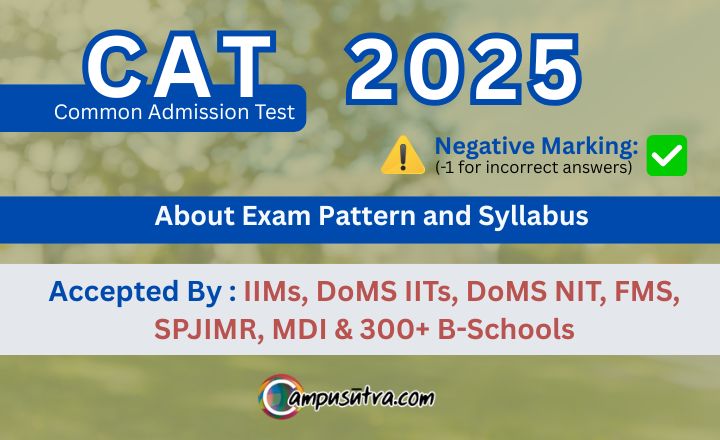CAT Exam: The Common Admission Test (CAT) is one of the most prominent and competitive computer-based entrance examinations in India, primarily for admission to postgraduate management programs (MBA/PGDM) offered by the Indian Institutes of Management (IIMs) and other top business schools across the country.
Apply to any top 250 B Schools from one window. Shortlist, save. CLICK
Overview of the CAT exam: The CAT is a national-level entrance exam conducted annually by one of the IIMs on a rotational basis. It assesses a candidate’s abilities in three core areas: Verbal Ability and Reading Comprehension (VARC), Data Interpretation and Logical Reasoning (DILR), and Quantitative Aptitude (QA).
Eligibility Criteria
To be eligible for the CAT exam, a candidate must:
- Hold a Bachelor’s Degree with at least 50% marks or equivalent CGPA (45% for candidates belonging to SC, ST, and PwD categories) from a recognized university or educational institution.
- Candidates appearing for the final year of their Bachelor’s degree or equivalent qualification examination, as well as those who have completed their degree requirements and are awaiting results, can also apply provisionally.
- There is no age limit for appearing in the CAT exam.
- Work experience is not a mandatory requirement for appearing in CAT, though some B-schools consider it during admissions.
CAT Exam Pattern
The CAT exams pattern has evolved over the years but generally remains consistent. As of recent trends (and expected for CAT 2025):
- Mode: Computer-Based Test (CBT)
- Duration: 120 minutes (2 hours). PwD candidates get 160 minutes.
- Sections: Three sections, with a sectional time limit of 40 minutes for each:
- Verbal Ability and Reading Comprehension (VARC)
- Data Interpretation and Logical Reasoning (DILR)
- Quantitative Aptitude (QA)
- Order of Sections: Candidates must attempt the sections in a fixed order: VARC, then DILR, then QA.
- Number of Questions: The total number of questions is typically around 66-68.
- VARC: Approximately 24 questions
- DILR: Approximately 20-22 questions
- QA: Approximately 22 questions
- Question Types: A mix of Multiple Choice Questions (MCQs) and Type In The Answer (TITA) questions.
- Marking Scheme:
- +3 marks for each correct answer.
- -1 mark for each incorrect MCQ answer.
- No negative marking for TITA questions.
- No penalty for unattempted questions.
- Slots: The exam is typically held in three slots on the same day (morning, afternoon, evening).
- On-screen calculator: An on-screen calculator is provided.
All About XAT (Xavier Aptitude Test). Eligibility, Registration and Colleges
CAT Exam Syllabus
The CAT syllabus covers a wide range of topics within the three sections:
- Verbal Ability and Reading Comprehension (VARC):
- Reading Comprehension (RC): Passages from various genres (science & technology, business & economics, arts, society & culture, history & politics) followed by questions.
- Verbal Ability: Para Summary, Para Jumbles, Odd One Out, Para Completion, Grammar, Vocabulary (Synonyms, Antonyms, Idioms).
- Data Interpretation and Logical Reasoning (DILR):
- Data Interpretation (DI): Questions based on tables, line & bar graphs, pie charts, Venn diagrams, caselets, etc.
- Logical Reasoning (LR): Topics like linear and circular arrangements, blood relations, cubes, clocks, calendars, syllogisms, binary logic, series, puzzles, games & tournaments, network flow diagrams.
- Quantitative Aptitude (QA):
- Arithmetic: Percentages, Profit and Loss, Simple & Compound Interest, Ratio & Proportion, Time, Speed & Distance, Time & Work, Averages, Mixtures & Allegations.
- Algebra: Linear and Quadratic Equations, Logarithms, Inequalities, Functions, Progressions (AP, GP, HP).
- Geometry & Mensuration: Triangles, Circles, Polygons, Coordinate Geometry, Surface Area and Volume of 2D and 3D shapes.
- Number System: Divisibility rules, Factors & Multiples, LCM & HCF, Properties of numbers.
- Modern Math: Permutation & Combination, Probability, Set Theory, Binomial Theorem.
Preparation Tips
- Strengthen Fundamentals: Build a strong foundation in all three sections by revising basic concepts and formulas.
- Consistent Practice: Regular practice is crucial. Solve a variety of questions from different topics.
- Time Management: Practice solving questions within strict time limits. CAT is a speed-accuracy test.
- Mock Tests: Take a large number of full-length mock tests to simulate exam conditions, identify strengths and weaknesses, and improve time management and test-taking strategy. Analyze mock test results thoroughly.
- Focus on Accuracy: Due to negative marking, focus on solving questions accurately rather than attempting all questions.
- Read Regularly: For VARC, develop a habit of reading diverse articles, editorials, and books to improve reading speed, comprehension, and vocabulary.
- Revision: Regularly revise key concepts, formulas, and strategies.
About CAT: The CAT (Common Admission Test) is a highly competitive, national-level entrance exam in India for admission to postgraduate management programs, primarily at the Indian Institutes of Management (IIMs). It’s a computer-based exam.







